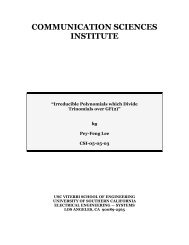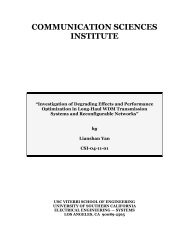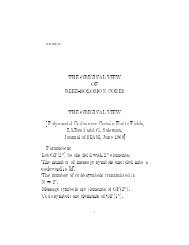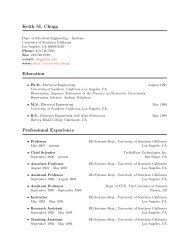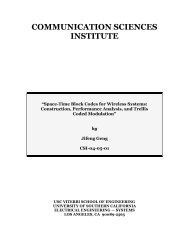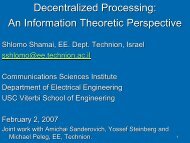Decoding Error-Correction Codes Utilizing Bit-Error Probability ...
Decoding Error-Correction Codes Utilizing Bit-Error Probability ...
Decoding Error-Correction Codes Utilizing Bit-Error Probability ...
You also want an ePaper? Increase the reach of your titles
YUMPU automatically turns print PDFs into web optimized ePapers that Google loves.
Reed-Solomon codes have many communication and memory applications and are very<br />
powerful in dealing with burst errors. Reed-Solomon codes also allow for a very efficient<br />
means of erasure decoding. An erasure is a symbol error with its location known to the<br />
decoder. However, in current or traditional decoding procedures, the locations of the<br />
error symbols are not known a-priori and must be estimated. Knowledge of the bit-error<br />
probabilities enable the decoder to determine, with considerable confidence, the symbols<br />
that have the highest likelihood of being in error. Once the locations of the most likely<br />
symbol errors are known, the decoder only needs to calculate the amplitudes of these<br />
symbol erasures to decode the codeword. Simulations were conducted on a (255,223) Reed-<br />
Solomon code over an additive white Gaussian noise (AWGN) channel to determine the<br />
accuracy of the symbol erasure estimate. <strong>Error</strong>/erasure decoding was performed using a<br />
combination of 15 errors and 2 erasures and compared to error only decoding for 16 errors<br />
using the Berlekamp-Massey algorithm. The performance of the error/erasure decoder<br />
yielded a slightly lower symbol error probability compared to the error only decoder.<br />
1.2 Organization of the Dissertation<br />
This dissertation consists of seven chapters with five appendices and is organized as follows:<br />
Chapter 1 is the introduction and the motivation for conducting the research in this<br />
dissertation. Chapter 2 establishes a rigorous mathematical development for the spectral<br />
representation of a real wide-sense stationary stochastic noise process, and develops the<br />
fundamental results of narrow-band stochastic processes. These concepts are fundamental<br />
to understanding the estimation methods used in the study.<br />
The first purpose of Chapter 3 is to analyze the Costas phase-locked loop under the<br />
strict requirement of perfect phase lock, that is, no phase error. It is shown that the<br />
correlation of the received signal with a coherent reference signal yields the following<br />
baseband representation: Signal corrupted with Gaussian noise at the output of the inphase<br />
(I) channel, and Gaussian noise only with no signal at the output of the quadrature<br />
(Q) channel. The second purpose of this chapter is to analyze the Costas circuit when<br />
3



